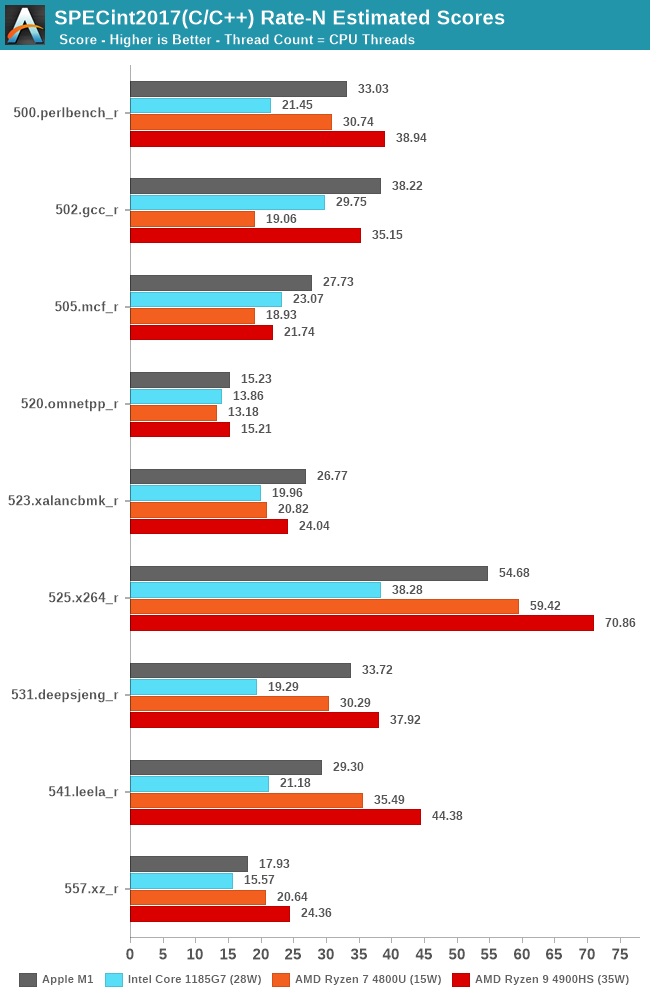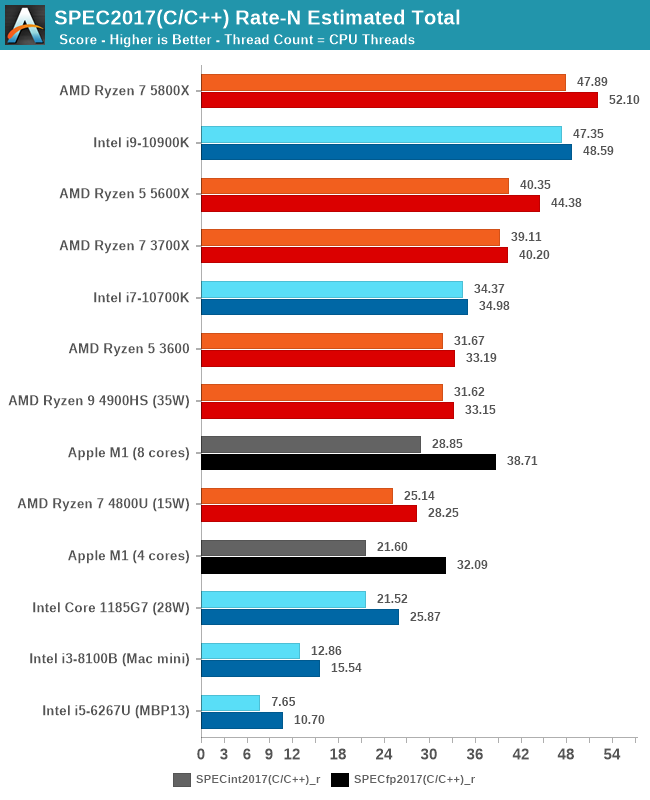The 2020 Mac Mini Unleashed: Putting Apple Silicon M1 To The Test
by Andrei Frumusanu on November 17, 2020 9:00 AM ESTSPEC2017 - Multi-Core Performance
While we knew that the Apple M1 would do extremely well in single-threaded performance, the design’s strengths are also in its power-efficiency which should directly translate to exceptionally good multi-threaded performance in power limited designs. We noted that although Apple doesn’t really publish any TDP figure, we estimate that the M1 here in the Mac mini behaves like a 20-24W TDP chip.
We’re including Intel’s newest Tiger Lake system with an i7-1185G7 at 28W, an AMD Ryzen 7 4800U at 15W, and a Ryzen 9 4900HS at 35W as comparison points. It’s to be noted that the actual power consumption of these devices should exceed that of their advertised TDPs, as it doesn’t account for DRAM or VRMs.

In SPECint2017 rate, the Apple M1 battles with AMD’s chipsets, with the results differing depending on the workload, sometimes winning, sometimes losing.

In the fp2017 rate results, we see similar results, with the Apple M1 battling it out with AMD’s higher-end laptop chip, able to beat the lower TDP part and clearly stay ahead of Intel’s design.

In the overall multi-core scores, the Apple M1 is extremely impressive. On integer workloads, it still seems that AMD’s more recent Renoir-based designs beat the M1 in performance, but only in the integer workloads and at a notably higher TDP and power consumption.
Apple’s lead against Intel’s Tiger Lake SoC at 28W here is indisputable, and shows the reason as to why Apple chose to abandon their long-term silicon partner of 15 years. The M1 not only beats the best Intel has to offer in this market-segment, but does so at less power.
I also included multi-threaded scores of the M1 when ignoring the 4 efficiency cores of the system. Here although it’s an “8-core” design, the heterogeneous nature of the CPUs means that performance is lop-sided towards the big cores. That doesn’t mean that the efficiency cores are absolutely weak: Using them still increases total throughput by 20-33%, depending on the workload, favouring compute-heavy tasks.
Overall, Apple doesn’t just deliver a viable silicon alternative to AMD and Intel, but actually something that’s well outperforms them both in absolute performance as well as power efficiency. Naturally, in higher power-level, higher-core count systems, the M1 can’t keep up to AMD and Intel designs, but that’s something Apple likely will want to address with subsequent designs in that category over the next 2 years.










682 Comments
View All Comments
mdriftmeyer - Saturday, November 21, 2020 - link
Threadripper Zen 3 Q12021. Lisa Su and team have already verified.vlad42 - Tuesday, November 17, 2020 - link
It is interesting that they might be working on higher end parts. However, I fear that only companies that are dedicated chip manufacturers/designers such as AMD, Intel, Arm, etc. can financially justify maintaining a sufficient update pace for low volume high end chips due to the fact that they have a much larger addressable market. The costs for those high end parts need to be made up after all.Since people have complained for a long time about the slow update pace for the iMac, Mac Mini, Mac Pro and any other desktop/workstation Mac I may be forgetting, maybe it will not matter?
I wonder if those dedicated high end chips could be a Mac Pro's CPU and GPU?
ABR - Wednesday, November 18, 2020 - link
I'm afraid this is what it looks like. The high end Macs will be updated even less often than they are now and be even further behind – both the lower end models as well as PCs that will be able to use the latest discrete graphics.alexvoda - Wednesday, November 18, 2020 - link
I anticipate that there will be no Apple Silicon Mac Pro.Apple will most probably introduce another M cpu for the MacBook Pro and the iMac simply because this one is capped at 16GB of RAM. It may even be the same chip but clocked higher thanks to the thermal headroom and without on-package RAM.
But I do not think Apple will develop a chip for a very niche product like the Mac Pro. Apple is not SGI. Apple's core market is not high end workstations.
We will probably see the Mac Pro continue to be updated as long as new x86 macOS versions are released and as long as Intel offers something worth updating to.
Or maybe a future Mac Pro will just be a multisocket design with regular iMac CPUs.
colinstalter - Wednesday, November 18, 2020 - link
I would totally agree with you, but they did say that they plan on doing the ENTIRE line. maybe it will just be a chiplette design like AMD. I really don't know, it's hard to imagine them competing in the high-TDP space, but if they say they'll do it i'm sure they will. Their problem will be that that their main strong point is great perf per watt. For the MacPro no one cares about that and just wants the most power possible within a 100-300 watt TDP.jbelkin - Thursday, November 19, 2020 - link
If Apple says 24 months, they mean in about 15, they will be done with the transition. They have already announced the new Mac Pro will be about half the size of the crrent one. The high end Pro market moves the slowest with plugs in and dongles so it makes sense they'll move slower.jbelkin - Thursday, November 19, 2020 - link
Apple owns the high end in laptops (the 1K+ market as the industry counts). 80-90% market share. Macs are about the size of McD's or State Farm, ONLY at Apple can a $25 BILLION dollar business unit be dismissed.BushLin - Thursday, November 19, 2020 - link
"Apple owns the high end in laptops (the 1K+ market as the industry counts). 80-90% market share" [Citation needed] (not really as it's obviously nonsense)Apple's valuation and profits largely come from iPhone sales and services.
MrCrispy - Tuesday, November 17, 2020 - link
First chip?? They've spent a decade designing and building iPhone/iPad SOCs which is exactly what M1 is with a different layout.This is a natural evolution of those. The most impressive part of this is actually Rosetta 2, and Apples's ability to transition the entire line - which comes from having a walled garden and captive developers/users who feed on hype, and not giving a crap about backwards compatibility.
Other companies don't have this luxury.
TEAMSWITCHER - Wednesday, November 18, 2020 - link
I don't see Apple hyping these products anymore than Intel, Nvidia, or AMD are hyping their own products. I do think that Apple delivered silicon that is competitive with what AMD and Intel are selling today, and it's now a three way race. I think that's a good thing.